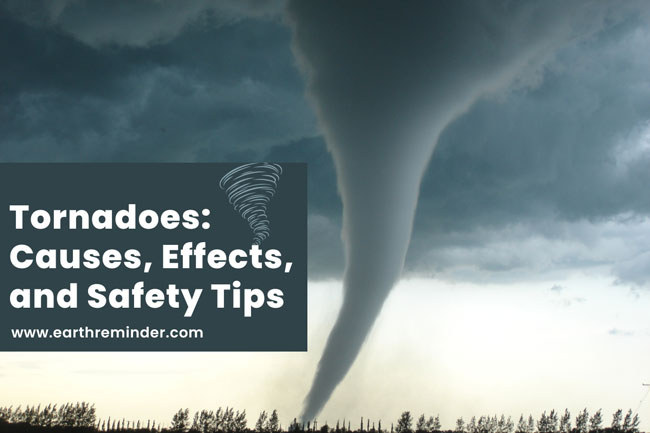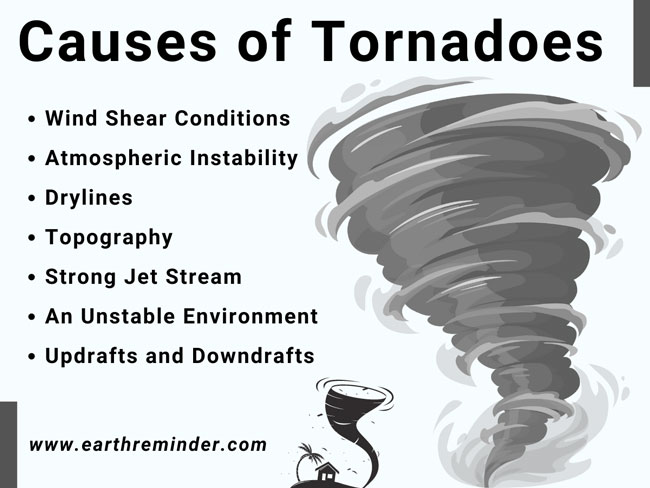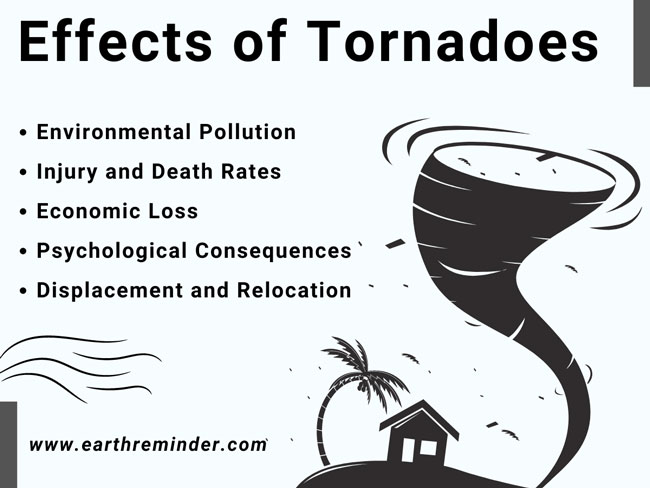Tornadoes: Causes, Effects, and Safety Tips
Tornadoes are dangerous and powerful natural disasters that can cause destruction and loss of life. They occur when warm, moist air meets cool, dry air, creating a powerful spinning column of air. Tornadoes destroy properties, infrastructure, and plants, and hurt humans and animals. While we can’t stop tornadoes from happening, reducing their impact is something we can do. Here, we will discuss the causes and effects of tornadoes, and identify some solutions that can assist us in preparing for and recovering from extreme weather events.
Table of Contents
What Are Tornadoes?
A Tornado is defined as a fast-rotating column of air that extends out of a thunderstorm all the way down to the earth’s uppermost layer. A tornado is a type of weather event that happens during thunderstorms. It’s like a big spinning wind tunnel that touches the ground and can move very quickly.
Tornadoes are the strongest storms in all of nature. Intense thunderstorms that cause tornadoes have the power to quickly kill individuals and completely demolish a neighborhood. A Tornado’s wind speed could exceed 300 miles per hour.
The damaged roads caused by tornadoes can be very big – more than a mile wide and fifty miles long. Strong downburst winds may also arise as a result of the same thunderstorm.
When tornadoes are formed, they are often accompanied by hail, which is small, hard balls of ice that fall from the sky. Every state is impacted in some way by this risk. On average, the USA experiences 1,200 tornadoes per year, more than any other country in the world.
Several Tornadoes are clearly visible, but others are hidden by surrounding low-lying clouds or rain. Tornadoes could form quickly and break apart almost as quickly. Most of these events last less than 15 minutes on average.
What Are the Causes of Tornadoes?
There are many reasons why tornadoes form, but some of the primary ones are hot and cold air mixing together, wind changes, and thunderstorms. They are very powerful storms that destroy houses and hurt people. To keep ourselves and others safe, we need to understand what causes tornadoes.
Atmospheric Instability
When there are different temperatures in the upper and lower atmosphere, along with high humidity in the lower atmosphere, it leads to instability. This instability occurs because the cooler layer in the upper atmosphere makes it difficult for the warm, moist air to rise. Also, wind shear can occur when there is a sudden shift in the wind’s speed or direction, such as when winds on the ground are much slower than those at a higher altitude.
Wind Shear Conditions
Wind shear refers to a change in wind speed and direction over a short distance. It can contribute to the formation of a Tornado by causing the air to spin. As the spinning column of air stretches and contracts, its rotation rate increases due to the conservation of angular momentum. The result is a Tornado, which is a violently swirling column of air.
Wind speed varies depending on factors like location, time of year, and weather patterns. It generally increases with altitude. At sea level, wind speed is around 6-12 mph. At 3,000 feet above sea level, it’s around 23-29 mph.
Updrafts and Downdrafts of Air Currents
One of the main causes of tornadoes is the difference between warm and cold air. Warm air is generally lighter and rises up, while cold air is heavier and sinks down. This creates a vertical movement of air called an updraft or a downdraft.
Updrafts are strong upward currents of air that are caused by warm air rising from the ground. These updrafts can eventually grow into tornadoes.
Downdrafts are strong downward currents of air that can occur during a thunderstorm. During downdrafts, cool air can come down from the top of the atmosphere, causing the wind to shift, which leads to a tornado.
Tornadoes happen when these air currents meet and form a spinning column of air that stretches from the clouds to the ground. Other variables like unstable air and wind shear also play a part in it.
Also Read: Causes of Extreme Weather.
Strong Jet Stream
You can imagine a fast wind blowing high in the sky. If this wind meets warm, moist air and cold, dry air it can create a spinning motion. This spinning motion can get stronger and reach the ground, making it a tornado. This strong wind high up in the sky is called a jet stream, and it gives a tornado a lot of energy. In other words, strong jet streams can cause tornadoes because they make the air spin and create conditions for them to form.
The jet stream is a swiftly flowing air that normally travels 30,000 and 40,000 feet above the earth’s surface. It can significantly affect surface climate patterns, such as the formation of Tornadoes.
Drylines
Drylines are boundaries between moist and dry air masses. It is a weather phenomenon that can cause thunderstorms in the spring and early summer. Storms can be triggered by drylines in the Plains states. When it moves eastward in the afternoon, severe thunderstorms can form along or near it, which may produce tornadoes, strong winds, and hail that can cause damage.
Topography
Topography refers to the physical features of the land, such as mountains, valleys, hills, and other surface irregularities. It can change wind patterns and affect updrafts, impacting tornado formation and movement. For example, mountains can stop tornadoes as well as change their direction, while valleys can guide them.
An Unstable Environment
An unstable environment is also one of the factors behind tornadoes. An unsettled atmosphere increases the chances of a tornado when temperatures and humidity change suddenly. The temperature and humidity can also rise and fall when things are placed near heat sources, like heaters, fireplaces, or outside walls. The instability in the atmosphere can lead to more tornadoes and damage.
What Are the Effects of Tornadoes?
The impact of a tornado varies depending on its strength. A more powerful tornado is capable of completely devastating a significant portion of the impacted city, whilst a weaker tornado only causes minor property damage. There are several thunderstorms, but the tornado is the one that causes the most destruction. These are all the effects of tornadoes:
Environmental Pollution
Tornadoes create pollution in different ways. For example, tornadoes can spread harmful chemicals, dust, and other pollutants into the air, water, and soil. Floods caused by tornadoes can also pollute the water with pollutants from factories, homes, and other sources.
Tornadoes destroy trees and vehicles, causing environmental pollution, leaving debris and contaminants across the landscape, polluting the soil. Tornadoes also produce a lot of noise, which can lead to stress, hearing damage, and other health problems.
The dust has an effect on how well the lungs work and increases the risk of lung disease. As a result, it causes ongoing heart problems or problems of the respiratory system.
Injury and Death Rates
Tornadoes are among the most severe types of weather. The number of people killed by Tornadoes varies greatly from year to year. The ferocity of Tornadoes can result in serious injuries and fatalities.
Check the below facts for a better understanding:
- According to the National Weather Service, the average annual death toll linked to tornadoes is 71 people in the United States.
- The NOAA reports that, on average, tornadoes in the United States result in around 80 fatalities and over 1,500 injuries each year. But these numbers can vary widely from year to year and from one tornado event to another.
- Violent Tornadoes (F4/F5) only account for one percent of all tornadoes, but cause 70 percent of all tornado deaths.
- The Tri-State tornado that happened on March 18, 1925, is one of the deadliest tornado in history. It lasted for more than three hours and tragically took the lives of 695 people.
As you can see above, tornadoes have a devastating impact on humans and other species.
Economic Loss
Tornadoes can have a major impact on the economy of affected areas. They may cause property damage, business interruptions, job losses, increased costs, insurance expenses, and a decline in tourism.
Businesses may suffer revenue loss and supply chain disruption due to damaged buildings and infrastructure. There’s also a chance that goods and services will get more expensive due to increased demand for repair services. A tornado can be devastating to small businesses and individuals, who may find it hard to recover.
Tornadoes often hit cities, causing extensive property damage, a significant economic impact, and indirect environmental damage. For example,
- In 1999, the Moore twister wreaked havoc on Oklahoma, resulting in a staggering $1.1 billion worth of damage. A more recent example is the 2011 Joplin tornado in Missouri, which caused property damage estimated at $3 billion.
- Tornadoes caused the United States about 229 million dollars in damage in 2021, the lowest amount since 2016.
A powerful Tornado can completely demolish a home in seconds, leaving the family homeless. The family is consequently compelled to remain in crowded shelters with limited or no hygienic amenities. Also, Protozoa infections and other water-borne diseases, including cholera, start spreading.
Psychological Consequences
Tornadoes can have a big psychological impact on people and communities. Survivors may experience symptoms of PTSD, anxiety, depression, grief, survivor guilt, fear, avoidance, and substance abuse.
For those who have been affected, it is crucial to get support and counselling so that long-term damage is prevented. You need early intervention to deal with these psychological consequences and promote resilience.
According to research, 10-20% of people affected by a disaster experience clinically significant mental health problems. The people directly involved in the incident displayed strong emotional reactions, and they might or might not be normal.
Tornadoes can bring back traumatic memories in which the victim helps relieve the incident and suffers from severe despair, withdrawal, anxiety, and intense fear of losing everything and death.
Displacement and Relocation
When a tornado hits an area, it can damage buildings and homes. People may have to leave their homes to find a temporary place to stay. Finding an appropriate place to live can be very difficult and stressful. People may also have to change their schools, jobs, and doctors. People can feel anxious, sad, and unsure about the future when they’re away from home. Therefore, when a tornado happens, people have no choice but to move out of their homes, and this can cause a lot of problems.
Also Read: Consequences of Extreme Weather.
How To Stay Safe In A Tornado? – 10 Tornado Safety Tips
Although Tornadoes can be devastating, there are precautions you can take to lessen the risk to you and your dear ones. Though they tend to occur more frequently in certain regions, tornadoes can strike anywhere, anytime. And because extreme weather events happen more often, it has become increasingly important to plan ahead to minimize the effects of these events. The following 10 safety tips should be noted:
- Avoid looking out of windows or seek additional safety by hiding under big, sturdy pieces of furniture. This will provide some protection from falling debris and keep you safe until the tornado passes.
- Avoid the corners of the room since they could draw additional debris by moving to the center. If you’re in a small room, like a bathroom or closet, crouch down and shield your head with your hands from any falling debris.
- Bring any pets you may have along but you should make sure to keep your pets under control to ensure everyone’s safety.
- Avoid travelling in cars and mobile houses as they offer little protection during tornadoes. As normal vehicles don’t provide much protection from the strong winds and debris that tornadoes can produce.
- You should take cover by draping your arms across your head and neck and protect yourself further with a coat and blanket. If possible, try to find a sturdy object to hold onto to keep yourself stable.
- Anybody in the path of a tornado must seek shelter inside, ideally in a basement. The basement is usually the safest place during a tornado because it provides protection from flying items and strong winds. Your lowest level interior room should be your shelter if you don’t have a basement. Make sure there are no windows over there.
- In case of power outages or other situations, ensure your phone is fully charged. If you have a portable charger, make sure it’s fully charged as well. By keeping your phone charged, you can stay informed about the tornado and receive updates from local authorities.
- Observe weather forecasts and tornado warnings. Prepare a strategy on what to do in the case of a tornado. You should have a plan in place for what to do in the event of a tornado, such as identifying a safe location in your home or nearby building. Also, discuss this plan with your family.
- Tornadoes can form quickly before a legal warning is given. Tornado warning signals include dark, usually greenish clouds, huge hail, a cloud of debris or even a funnel cloud, and a roaring sound. Make sure your children are aware of such signals and tell them to take them seriously.
- Make sure you bring any necessary supplies, like food, water, and a first-aid kit, with you to your shelter.
Remember to always stay alert and listen to local authorities for instructions on how to stay safe during a tornado.
Also Read: What is the Difference Between Weather and Climate?
Conclusion
Tornadoes are an example of severe weather phenomena that can result in significant property destruction and deaths. They are distinguished by an air column that extends from the base of a thunderstorm cloud to the ground and rotates quickly. Although they can happen anywhere worldwide, tornadoes are more common in the United States.
Although tornadoes are a natural occurrence that cannot be controlled, there are efforts that people and communities may make to reduce the risk and harm they cause. These include putting together a strategy for severe weather, keeping up with local weather reports, and taking cover in a complex structure and underground shelter whenever a tornado is nearby.
Thus, tornado causes and effects require individual and collective action, as well as ongoing research and development to improve our understanding of these extremely complex events. Together, we can protect our communities from tornadoes by increasing our resilience and preparedness.


